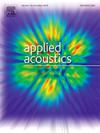Gas pipeline leakage identification and location using microporous structure optical sensing cable
IF 3.4
2区 物理与天体物理
Q1 ACOUSTICS
引用次数: 0
Abstract
Existing leakage detection systems face high costs and significant challenges in identifying and locating pinhole leakage in long-distance gas pipelines. A gas pipeline leakage monitoring model test was designed using distributed acoustic sensing (DAS) technology. The developed microporous structure optical sensing cable (MS cable) effectively slows down the attenuation of the leakage signal. A method for pipeline leakage signal identification and precise location based on fast Fourier transform (FFT) is proposed. By analyzing the vibration of the optical fiber in both time and frequency domains, leakage signals can be accurately monitored. The preliminary location of the leakage point is determined based on the variation pattern of the spectral average amplitude of each sensing channel, and an accurate leakage signal location method based on the cross-correlation algorithm is proposed, enhancing the positioning accuracy of the MS cable from 7.96 m to 0.11 m.
求助全文
约1分钟内获得全文
求助全文
来源期刊

Applied Acoustics
物理-声学
CiteScore
7.40
自引率
11.80%
发文量
618
审稿时长
7.5 months
期刊介绍:
Since its launch in 1968, Applied Acoustics has been publishing high quality research papers providing state-of-the-art coverage of research findings for engineers and scientists involved in applications of acoustics in the widest sense.
Applied Acoustics looks not only at recent developments in the understanding of acoustics but also at ways of exploiting that understanding. The Journal aims to encourage the exchange of practical experience through publication and in so doing creates a fund of technological information that can be used for solving related problems. The presentation of information in graphical or tabular form is especially encouraged. If a report of a mathematical development is a necessary part of a paper it is important to ensure that it is there only as an integral part of a practical solution to a problem and is supported by data. Applied Acoustics encourages the exchange of practical experience in the following ways: • Complete Papers • Short Technical Notes • Review Articles; and thereby provides a wealth of technological information that can be used to solve related problems.
Manuscripts that address all fields of applications of acoustics ranging from medicine and NDT to the environment and buildings are welcome.
 求助内容:
求助内容: 应助结果提醒方式:
应助结果提醒方式:


